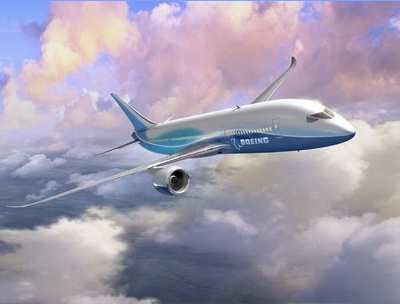Tue, May 06, 2003
Concept Design Pushes Boeing Engineers to Consider Innovative
Approaches
 Boeing has released a new image of its
super-efficient 7E7 commercial airplane. Engineers are using this
7E7 concept to push their thinking to more innovative exterior
designs for the new airplane. The new image shows a distinctive
nose shape, new wing tip concepts and a sculpted vertical tail
structure.
Boeing has released a new image of its
super-efficient 7E7 commercial airplane. Engineers are using this
7E7 concept to push their thinking to more innovative exterior
designs for the new airplane. The new image shows a distinctive
nose shape, new wing tip concepts and a sculpted vertical tail
structure.
“The basic shape of large commercial jet airplanes has
remained essentially unchanged since the introduction of the Boeing
707 nearly 50 years ago,” said Mike Bair, senior vice
president of the 7E7 program. “There’s a good reason
for that. The shape is optimal for achieving lift, fighting drag
and producing efficient, comfortable flight.”

Subtle touches, however, can be added to produce a more unique
shape without affecting the performance of the airplane. Engineers
are studying these touches for consideration on the new 7E7.
“We are using this concept similar to how automobile
designers use concept cars, to stretch our imaginations, to
consider new possibilities and to help us design the best possible
product for our customer,” Bair said. “The conventional
image that we have shown the world for the past four months is very
much our baseline design. But we want to go beyond baseline to
something that people will know by sight -- like the way we all
know a 747 when we see one.”
 Designers will continue to consider alternative
design features through the summer and finalize the airplane
configuration by the end of the year. “Airplane designs
change during development,” Bair said (right). “I
don’t expect the 7E7 will look exactly like either the
baseline image we’ve shown since January or this concept
image. I expect we will take the best of both to come up with
something unique that meets the needs of our customers and
satisfies the flying public.”
Designers will continue to consider alternative
design features through the summer and finalize the airplane
configuration by the end of the year. “Airplane designs
change during development,” Bair said (right). “I
don’t expect the 7E7 will look exactly like either the
baseline image we’ve shown since January or this concept
image. I expect we will take the best of both to come up with
something unique that meets the needs of our customers and
satisfies the flying public.”
The 7E7 is being developed as a 200- to 250-seat airplane that
will fly between 7,000 and 8,000 nautical miles at speeds similar
to today's fastest twin-aisle commercial airplanes – the 777
and 747. It will be the most advanced and efficient commercial
airplane in its class and will set new standards for environmental
responsibility and passenger comfort.
The market potential for a new airplane of this size is
forecasted at up to 3,000 units over the next 20 years. The company
expects to formally offer the new airplane to customers in early
2004.
More News
Aero Linx: Transport Canada We are a federal institution, leading the Transport Canada portfolio and working with our partners. Transport Canada is responsible for transportation p>[...]
Gross Navigation Error (GNE) A lateral deviation from a cleared track, normally in excess of 25 Nautical Miles (NM). More stringent standards (for example, 10NM in some parts of th>[...]
From AirVenture 2017 (YouTube Edition): Flight-Proven Booster On Display At AirVenture… EAA AirVenture Oshkosh is known primarily as a celebration of experimental and amateu>[...]
Aircraft Parachute System (CAPS) Was Deployed About 293 Ft Above Ground Level, Which Was Too Low To Allow For Full Deployment Of The Parachute System Analysis: The day before the a>[...]
Also: 48th Annual Air Race Classic, Hot Air Balloon Fire, FAA v Banning 100LL, Complete Remote Pilot The news Piper PA-18 Super Cub owners have been waiting for has finally arrived>[...]
 ANN's Daily Aero-Linx (06.29.25)
ANN's Daily Aero-Linx (06.29.25) ANN's Daily Aero-Term (06.29.25): Gross Navigation Error (GNE)
ANN's Daily Aero-Term (06.29.25): Gross Navigation Error (GNE) Classic Aero-TV: Anticipating Futurespace - Blue Origin Visits Airventure 2017
Classic Aero-TV: Anticipating Futurespace - Blue Origin Visits Airventure 2017 NTSB Final Report: Cirrus SR22
NTSB Final Report: Cirrus SR22 Airborne Affordable Flyers 06.26.25: PA18 Upgrades, Delta Force, Rhinebeck
Airborne Affordable Flyers 06.26.25: PA18 Upgrades, Delta Force, Rhinebeck





